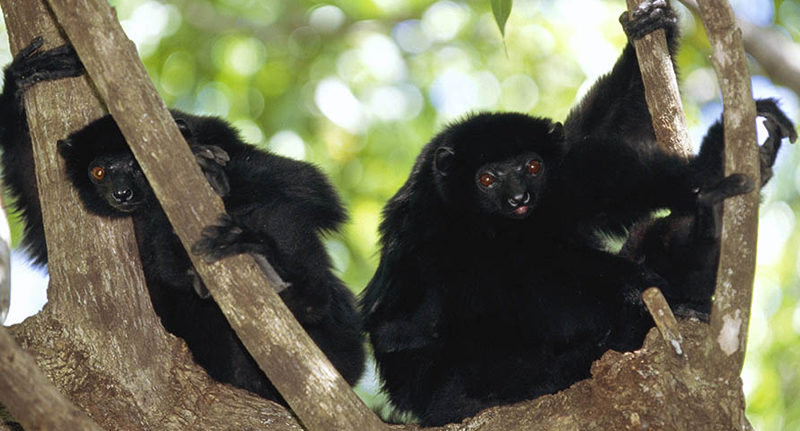Discover the Rare All-Black Sifaka in Madagascar: A Wildlife Adventure
Madagascar, often called the “eighth continent” for its extraordinary biodiversity, is home to species found nowhere else on Earth. Among its most striking and elusive inhabitants is the all-black sifaka (Propithecus coronatus), a lemur that captivates wildlife enthusiasts and researchers alike. For those seeking an unforgettable adventure, a wildlife tour in Madagascar offers the chance to spot this rare primate in its natural habitat, which is a bucket-list experience.
Distribution of Madagascar Wildlife: Northern Dry Forests
The all-black sifaka has a highly restricted range, inhabiting only a small area of dry deciduous forest in northern Madagascar. Its limited distribution makes this lemur particularly vulnerable to habitat loss and environmental pressures. These forests are part of a unique ecosystem where endemic plants, birds, and other lemur species coexist, offering visitors a rare glimpse into Madagascar wildlife in its pristine form.
Primary locations to see the all-black sifaka include:
-
Andrafiamena Protected Area – Managed by the NGO FANAMBY, this reserve focuses on conservation and community-based eco-tourism.
-
Analamerana Special Reserve – Administered by Madagascar National Parks, this reserve protects key habitats for the species and other Madagascar lemurs.
Both areas provide opportunities to witness wild Madagascar wildlife while supporting vital conservation efforts.
Identifying Madagascar Lemurs: The All-Black Sifaka
The all-black sifaka is instantly recognizable due to its entirely black coat, setting it apart from other sifakas with white or brown fur. Its striking appearance, combined with graceful movements through the forest canopy, makes it a favorite among wildlife photographers and nature lovers exploring Madagascar wildlife.
Physically, the all-black sifaka shares similarities with other sifakas, including long limbs adapted for leaping, but its coloration is unique among lemurs in northern Madagascar.
Madagascar Wildlife Sounds: The Explosive Sifaka Call
One of the most fascinating aspects of the all-black sifaka is its distinctive vocalization, often described as an explosive sneezing sound. This call plays an important role in Madagascar wildlife communication:
-
Group communication – Maintains cohesion within family units.
-
Territorial signaling – Alerts neighboring groups of presence.
-
Visitor alerts – Helps tourists locate these elusive primates.
Hearing the all-black sifaka’s call echo through northern Madagascar forests adds an unforgettable sensory experience to your wildlife adventure.
Social Behavior of Madagascar Lemurs: Small, Close-Knit Groups
Like other sifakas, the all-black sifaka is diurnal and social, though groups are smaller, typically ranging from 2 to 6 individuals. Observing their behavior offers a unique insight into Madagascar wildlife dynamics:
-
Playful interactions – Young sifakas leap and chase each other through the trees.
-
Grooming rituals – Strengthen social bonds within the group.
-
Acrobatic leaping – Sifakas can jump 10–15 meters between trees, a breathtaking sight for wildlife enthusiasts.
Best Madagascar Wildlife Destinations to See the All-Black Sifaka
Visiting the all-black sifaka requires trips to specialized protected areas in northern Madagascar, guided by local experts.
Andrafiamena Protected Area: A Hub for Madagascar Wildlife
-
Managed by NGO FANAMBY, this reserve emphasizes conservation of Madagascar wildlife.
-
Accommodation options include the community campsite and the Black Lemur Camp Lodge, combining comfort and eco-tourism.
-
Guided tours allow visitors to see the all-black sifaka, other lemur species, endemic birds, and unique flora.
Analamerana Special Reserve: Remote Madagascar Wildlife Experience
-
Administered by Madagascar National Parks, this reserve protects critical dry forest habitats.
-
Offers secluded wildlife experiences for adventurous travelers.
-
Ideal for observing rare Madagascar lemurs and capturing unique wildlife photographs.
Conservation of Madagascar Wildlife: Protecting the All-Black Sifaka
The all-black sifaka is critically endangered, threatened by:
-
Deforestation – Logging and agriculture reduce habitat.
-
Hunting – Occasional bushmeat hunting.
-
Climate change – Impacts forest composition and food sources.
Conservation initiatives focus on protecting habitats, engaging local communities, and research. Visiting Andrafiamena and Analamerana helps fund these programs, making tourism a tool for Madagascar wildlife preservation.
Community Involvement in Wildlife Conservation
Local communities play a key role in conserving Madagascar wildlife:
-
Villagers earn income from guiding, lodging, and cultural activities.
-
Educational programs increase awareness about lemur protection.
-
Sustainable practices ensure tourism does not harm fragile ecosystems.
When to Visit Northern Madagascar
The dry season (April to November) is ideal for observing the all-black sifaka:
-
Trails are accessible and safer for trekking.
-
Lemurs are more active and easier to spot.
-
Photography conditions are optimal with clear skies and good light.
Visiting outside this period is possible but may require extra preparation for wet conditions.
Tips for Photographing Madagascar Wildlife
Capturing images of the all-black sifaka can be challenging. Wildlife photographers should consider:
-
Telephoto lenses – Essential for photographing from a distance without disturbing lemurs.
-
Patience – Wait quietly to observe natural behaviors.
-
Focus on action – Capture leaping, grooming, or social interactions.
-
Respect wildlife – Avoid feeding or approaching animals.
By following these guidelines, visitors can create stunning photographs of Madagascar wildlife responsibly.
Plan Your Wildlife Tour with HT Agency Tours
HT Agency Tours specializes in tailored Madagascar wildlife tours, ensuring:
-
Expert guides with in-depth knowledge of Madagascar lemurs.
-
Comfortable eco-lodges and community-based campsites.
-
Opportunities to engage with local culture and conservation initiatives.
-
Small-group experiences for a personalized wildlife adventure.
Our tours to Andrafiamena and Analamerana allow visitors to witness the rare all-black sifaka, other lemur species, and unique Madagascar flora and fauna while supporting conservation.
Final Thoughts on Madagascar Wildlife
The all-black sifaka is a symbol of Madagascar’s incredible biodiversity and the importance of conservation. Observing this rare lemur, hearing its explosive calls, and watching its acrobatic leaps provides a once-in-a-lifetime wildlife experience.
Choosing responsible travel with HT Agency Tours ensures your adventure supports Madagascar wildlife conservationand helps protect these extraordinary ecosystems for future generations.
Related Research:
-
Madagascar lemurs
-
Madagascar eco-tourism
-
Rare lemurs in Madagascar
-
Wildlife photography Madagascar
Luxury Madagascar with the best luxury African safari tours packages. Discover your next perfect destination with HT Agency Tours
Madagascar Wildlife Tour Package
